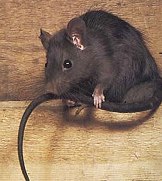| |

Call
now
to solve your wildlife problem!
727-710-0373
Serving
Tampa Bay with wildlife
7 days a week
Click
here for a free estimate
Rats are
very common in the Tampa Bay area.
They are very active at night and feed on many natural sources as well as garbage, pet food and bird feeders. We specialize in Tampa rat removal.
Rats will commonly be found nesting in Palm trees and other natural sources but they never stray far from humans. They prefer nice warm and dry attics over the outdoors. While they can force their way in many structures by chewing, they most often find an easy way in through a construction gap or decay.
The Trapper Guy is an expert in rat removal.
727-710-0373
|
Roof
Rat
Order Rodentia : Family Muridae : Rattus
rattus (Linnaeus)
Description. A blackish
(or brownish), medium-sized, slender
rat with long, naked, scaly tail; tail
usually longer than head and body but
not always so. External measurements
average: total length, 370 mm; tail,
190 mm; hind foot, 36 mm. Weight, up
to 200 g.
Distribution in Texas.
Common over most of Texas, especially
in towns.
Habits. Roof rats are
largely commensals and live in close
association with man. They seldom become
established as feral animals as do the
Norway rats. They inhabited grocery
and drug stores, warehouses, feed stores,
and poultry houses and were very common
in cotton gins and associated grain
warehouses. On the farms they lived
in barns and corncribs. They may live
near the ground, but usually they frequent
the attics, rafters, and crossbeams
of the buildings. They make typical
runways along pipes, beams or wires,
up and down the studding, or along the
horizontal ceiling joists, often leaving
a dark-colored layer of grease and dirt
to mark their travelways. Like the Norway
rat, the roof rat is largely nocturnal
and only where populations are relatively
high does one see them frequently in
the daytime. There is some indication
that the larger and more aggressive
Norway rat is supplanting the roof rat
in many parts of the United States.
In the southern United States, however,
the roof rat is by far the more common
of the two.
They accept a wide variety
of food items, including grains, meats,
and almost any item that has nutritive
value.
Roof rats breed throughout
the year, with two peaks of production
— in February and March and again in
May and June. The period of least activity
is in July and August. The gestation
period is approximately 21 days, and
the number of young per litter averages
almost seven. The young rats at birth
are naked, blind, and nearly helpless.
They mature rather rapidly, are weaned
when about 3 weeks old, and are able
to reproduce when approximately 3 months
old. In Texas, young females with a
head and body length of 125 mm were
sexually mature. Like the Norway rat,
the roof rat is destructive to property
and foodstuffs. Also, it plays an important
part in the transmission of such human
diseases as endemic typhus, ratbite
fever, and bubonic plague.
|
|
|

Rat
Let
me help you with your rat removal problems.
|
| 
About
Dave
The
Trapper Guy is not a pest control
company. I do not
use poisons or service bugs.
|

|
|